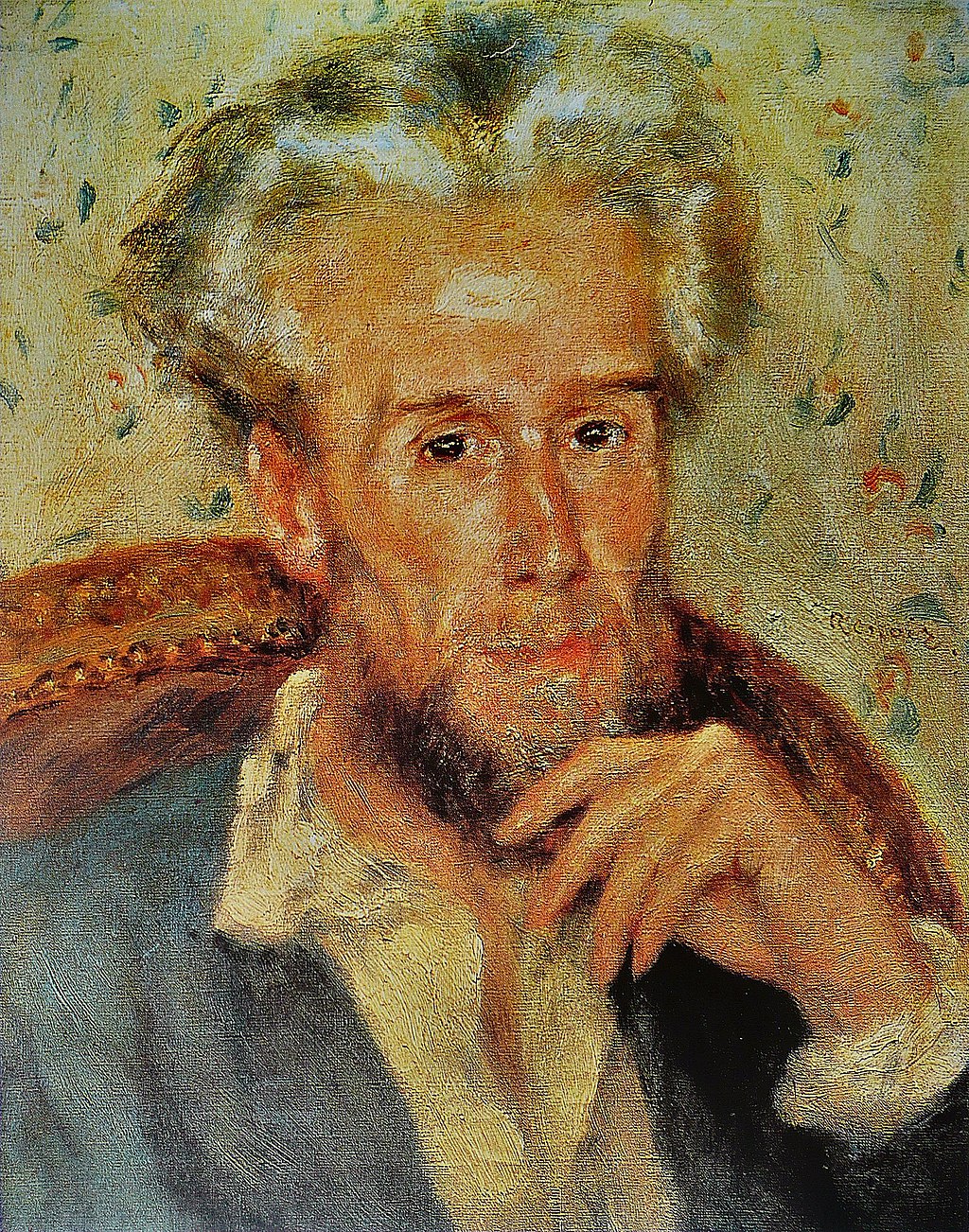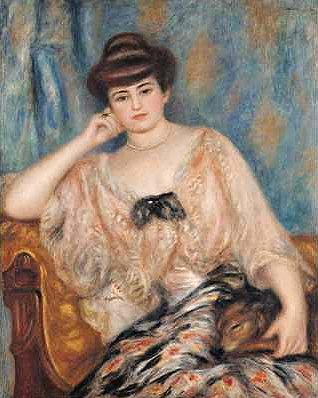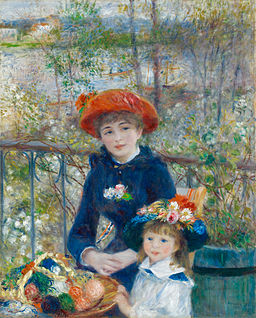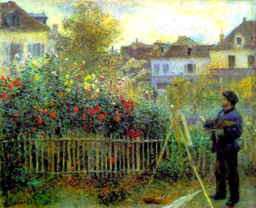
Pierre-Auguste Renoir (1841 – 1919), commonly known as Auguste Renoir, was a leading painter in developing the Impressionist style.
As one who celebrated beauty and especially feminine sensuality, Renoir’s paintings are notable for their vibrant light and saturated color, most often focusing on people in intimate and candid compositions.
In characteristic Impressionist style, Renoir suggested a scene’s details through freely brushed touches of color so that his figures softly fuse with their surroundings.
At the age of 51, Renoir developed rheumatoid arthritis, which severely limited his mobility in his last twenty years of his life.
He developed progressive deformities in his hands and ankylosis of his right shoulder, requiring him to change his painting technique.
Renoir remained positive and passionate about his art and did not let his condition affect his painting or diminish the beauty that he saw around him. In his arthritis’s advanced stages, he required an assistant to place his paintbrush in his hand.
His hands were also wrapped with bandages to prevent skin irritation. Renoir applied various effective coping strategies and used his ingenuity to come up with different ways to continue painting even as his arthritis weakened him.
Renoir was a prolific artist who created several thousand paintings. The single most extensive collection of his works, about 181 pictures, is part of the Barnes Foundation in Philadelphia.
A Virtual Tour of Pierre-Auguste Renoir
- Dance at Le Moulin de la Galette
- Dance at Bougival
- The Large Bathers
- The Theater Box
- Collette’s House in Cagnes
- Luncheon of the Boating Party
- In Summer
- Country Dance
- Two Sisters
- Portrait of Misia Godebska-Sert
- Pierre-Auguste Renoir
- La Grenouillère (Nationalmuseum)
- La Grenouillère
- Claude Monet Painting in His Garden at Argenteuil
- Mother and Children (La Promenade)
Pierre-Auguste Renoir
- Name: Pierre-Auguste Renoir
- Born: 1841 – Limoges, Haute-Vienne, France
- Died: 1919 (aged 78) – Provence-Alpes-Côte d’Azur, France
- Nationality: French
- Movement: Impressionism
Highlights of Pierre-Auguste Renoir
Dance at Le Moulin de la Galette
“Dance at Le Moulin de la Galette” is also known as “Bal du Moulin de la Galette” and is one of Pierre-Auguste Renoir’s most famous works.
The Moulin de la Galette was an outdoor dancehall and café, frequented by many of Renoir’s friends. Renoir was a regular, and he enjoyed the atmosphere.
The Moulin de la Galette was one of the several windmills located in Montmartre, a Paris district. The painting depicts a famous Parisian lifestyle during a typical Sunday afternoon in the late 1870s, when working-class Parisians would dress up and spend time dancing, drinking, and eating into the evening.

Dance at Bougival
“Dance at Bougival” by Pierre-Auguste Renoir, made in 1883, depicts two of Renoir’s friends dancing at one of the open-air cafés of suburban Bougival on the Seine outside Paris.
Renoir used intense color and lush brushwork to heighten the sense of pleasure conveyed by the whirling couple who dominate the painting.
The woman’s face, framed by her red bonnet and is the focus of attention. The woman’s body is arched to the dance as she turns her head and looks away, delighted with the pleasure she inspires in her dance partner and herself. Her dress swirls to the rhythms of the dance.

The Large Bathers
“The Large Bathers” or “Les Grandes Baigneuses” by Auguste Renoir depicts a scene of nude women bathing. The figures have a sculptural quality, while the landscape behind them is bathed in an impressionist light.
This painting was a new style for Renoir, who sought to reconcile the modern topics and painting styles with the 17th and 18th-century art traditions.
Renoir admired Rubens, Titian, and Raphael’s works, and he was trying to find an integrated form of the old masters and the new impressionist style.

The Theater Box
“The Theater Box” by Pierre-Auguste Renoir, also knew by its French name “La Loge,” shows a couple in their theater box.
At the time of this painting, the theater in Paris was a rapidly expanding form of entertainment and culture. The theater was a prominent place to meet people and to be seen.
Wealth and fashion were on parade. In this painting, Renoir focused upon the theater scene as a social stage where status and relationships were on public display.

Portrait of Misia Godebska-Sert
“Portrait of Misia Godebska-Sert” by Pierre-Auguste Renoir shows Misia Sert, née Godebska, a notable figure in the circle of artists in Paris at the turn of the century.
She first married in 1903, and later she married the Spanish painter José Maria Sert, and it is as Misia Sert that she is most remembered.
Misia Sert (1872 – 1950) was a Polish descent pianist who hosted an artistic salon in Paris and was a patron and friend to numerous artists.

Collette’s House in Cagnes
“Collette’s House in Cagnes” by Pierre-Auguste Renoir was painted by Renoir at the age of just over 70-year-old when Renoir lived at a farm on the hill Les Collettes in Cagnes-sur-Mer, the area he lived in until his death.
Renoir died in the village of Cagnes-sur-Mer, seven years after this painting. Renoir’s paintings are notable for their light and color, as in this painting.
The warmth of Renoir’s style made his paintings some of the most famous works in the history of art. Renoir uses the trees as a visual screen to integrate the foreground and background space.
Luncheon of the Boating Party
“Luncheon of the Boating Party” by Pierre-Auguste Renoir depicts a group of Renoir’s friends relaxing on a balcony at the Maison Fournaise restaurant, along the Seine river in Chatou, France. All of the figures in the painting have been identified, and their names are known.
Renoir’s future wife, Aline Chariot, is in the foreground playing with a small dog.

In Summer
“In Summer” by Pierre-Auguste Renoir is a portrait of twenty-year-old Lise Tréhot, who was Renoir’s companion from about 1866 to 1871.
He painted her at least 23 times, including Lise, with a parasol, painted in 1867, which was Renoir’s first significant critical success at the Paris Salon in 1868. This success inspired Renoir to repaint her, this time in a more informal and intimate style.

Country Dance
“Country Dance” by Pierre-Auguste Renoir shows a dancing couple under a chestnut tree. Both figures are painted life-size and occupy almost the entire painting.
The woman who holds a fan in her right hand is shown with a smiling face looking towards the viewer. The scene is bathed in a bright and cheerful light.
The background includes a table on the right. A hat on the ground and a pair of faces below the dance floor level can be seen.

Two Sisters
Two Sisters or On the Terrace by Pierre-Auguste Renoir depicts the upper terrace of the Maison Fournaise, a family restaurant located on an island in the Seine in Chatou, the western suburb of Paris.
The painting shows a young woman and her younger girl seated outdoors with a small basket containing wool balls. In the background over the railings of the terrace are flowering plants and vines.
Further in the background is the River Seine with boats and some buildings in the top left on the other side of the river.

La Grenouillère (Nationalmuseum)
“La Grenouillère” by Pierre-Auguste Renoir depicts La Grenouillère, a popular middle-class resort consisting of a spa, a boating establishment, and a floating café.
Monet and Renoir recognized in La Grenouillère an ideal subject for the images of leisure they hoped would sell.
The famous floating café “La Grenouillère” is where Claude Monet and Pierre-Auguste Renoir met at the end of the summer of 1869 to paint their first Impressionist paintings. Museum: Nationalmuseum, Stockholm

La Grenouillère
“La Grenouillère” by Pierre-Auguste Renoir depicts the La Grenouillère resort promoted as “Trouville-sur-Seine,” located on the Seine near Bougival, easily accessible by train from Paris and had just been favored with a visit by Emperor Napoleon III with his wife and son.

Claude Monet Painting in His Garden at Argenteuil
“Claude Monet Painting in His Garden at Argenteuil” by Pierre-Auguste Renoir depicts Monet’s famous impressionist at his painting easel painting in his garden in Argenteuil.
From 1871 to 1878, Claude Monet lived at Argenteuil, a village on the right bank of the Seine river near Paris, and a popular Sunday-outing destination for Parisians, where he painted some of his best-known works.
Claude Monet and Pierre-Auguste Renoir painted their first Impressionist paintings together at La Grenouillère in 1869 when they were both impoverished artists.
This painting of Monet by Renior was rendered four years later as they continued to struggle for recognition.
One year after this painting, their fortunes reached a turning-point as the two friends came together with others for the first Impressionist Exhibition in Paris. Museum: Wadsworth Atheneum, Hartford, Connecticut

Mother and Children (La Promenade)
“Mother and Children” by Pierre-Auguste Renoir shows a mother who gently guides her two daughters along a circling path in a public park. Together they form a triangular group set apart from the background figures and foliage.
The symmetry in the arrangement of the three blond figures lends a note of elegance. The mother and daughters are turned slightly to the right as they walk along the path.
The young girls are dressed alike and similarly posed. The elder seems more self-confident as she strides forward ahead of her mother, holding her doll in her clasped hands. The mother reassures the younger girl with her hand to her shoulder.
The background figures in the extreme upper right of the scene provide perspective and depth without taking the focus off the central group.
The greens and lavenders of the landscape are echoes of the turquoise and creamy white of the girls’ costumes and the rich blue of their mother’s jacket.

Pierre-Auguste Renoir Quotes
~~~
“The more they measure, the more they realize how much the Greeks departed from regular and banal lines to produce their effect.”
~~~
“Why should beauty be suspect?”
~~~
“There are quite enough unpleasant things in life without the need to manufacture more.”
~~~
“One must, from time to time, attempt things that are beyond one’s capacity.”
~~~
I think I’m beginning to learn something about it.”
~~~
“There’s nothing more absurd than a “connoisseur.”
~~~
“You come to nature with all your theories, and she knocks them all flat.”
~~~
“The pain passes, but the beauty remains.”
~~~
“When I’ve painted a woman’s bottom so that I want to touch it, then the painting is finished.”
~~~
“It is after you have lost your teeth that you can afford to buy steaks.”
~~~
“Why shouldn’t art be pretty? There are enough unpleasant things in the world.”
~~~
“It’s with my brush that I make love.”
~~~
“We are in a period of searchers rather than of creators.”
~~~
If it [dabbling in art] didn’t amuse me, I beg you to believe that I wouldn’t do it.
~~~
“Art is about emotion; if art needs to be explained, it is no longer art.”
~~~
“I have been for forty years, discovering that the queen of all colors was black.”
~~~
“What seems most significant to me about our movement [Impressionism] is that we have freed painting from the importance of the subject. I am at liberty to paint flowers and call them flowers, without their needing to tell a story.”
~~~
“I have arrived more definitely than any other painter during his lifetime; honors shower upon me from every side; artists pay me compliments on my work; there are many people to whom my position must seem enviable. But I don’t seem to have a single real friend!”
~~~
“The advantage of growing old is that you become aware of your mistakes more quickly.”
~~~
God, the king of artists, was clumsy.
~~~
Why should beauty be suspect?
~~~
They tell you that a tree is only a combination of chemical elements. I prefer to believe that God created it and that a nymph inhabits it.
~~~
A Tour of Artists you should Know
- Duccio (1255 – 1319)
- Jan van Eyck (1390 – 1441)
- Giovanni Bellini (1430 – 1516)
- Sandro Botticelli (1445 – 1510)
- Domenico Ghirlandaio (1448 – 1494)
- Leonardo da Vinci (1452 – 1519)
- Albrecht Durer (1471 – 1528)
- Lucas Cranach the Elder (1472 – 1553)
- Michelangelo (1475 – 1564)
- Raphael (1483 – 1520)
- Titian (1488 – 1576)
- Hans Holbein the Younger (1497 – 1543)
- Tintoretto (1518 – 1594)
- Pieter Bruegel the Elder (1525 – 1569)
- Paolo Veronese (1528 – 1588)
- El Greco (1541 – 1614)
- Caravaggio (1571 – 1610)
- Peter Paul Rubens (1577 – 1640)
- Georges de La Tour (1593 – 1652)
- Artemisia Gentileschi (1593 – 1656)
- Anthony van Dyck (1599 – 1641)
- Nicolas Poussin (1594 – 1665)
- Diego Velázquez (1599 – 1660)
- Rembrandt (1606 – 1669)
- Pieter de Hooch (1629 – 1684)
- Johannes Vermeer (1632 – 1675)
- Élisabeth Sophie Chéron (1648 – 1711)
- Canaletto (1697 – 1768)
- François Boucher (1703 – 1770)
- Jean-Honoré Fragonard (1732 – 1806)
- John Singleton Copley (1738 – 1815)
- Benjamin West (1738 – 1820)
- Angelica Kauffman (1741 – 1807)
- Francisco Goya (1746 – 1828)
- Jacques-Louis David (1748 – 1825)
- Antonio Canova (1757 – 1822)
- Katsushika Hokusai ( 1760 – 1849)
- Caspar David Friedrich (1774 – 1840)
- J.M.W. Turner (1775 – 1851)
- Jean-Auguste-Dominique Ingres (1780 – 1867)
- William Etty (1787 – 1849)
- Eugène Delacroix (1798 – 1863)
- George Caleb Bingham (1811 – 1879)
- Rosa Bonheur (1822 – 1899)
- Jean-Léon Gérôme (1824 – 1904)
- Dante Gabriel Rossetti (1828 – 1882)
- John Everett Millais (1829 – 1896)
- Frederic Leighton (1830 – 1896)
- Camille Pissarro (1830 – 1903 )
- Édouard Manet (1832 – 1883)
- James Abbott McNeill Whistler (1834 – 1903)
- Edgar Degas (1834 – 1917)
- James Tissot (1836 – 1902)
- Winslow Homer (1836 – 1910)
- Paul Cézanne (1839 – 1906)
- Auguste Rodin (1840 – 1917)
- Claude Monet (1840 – 1926)
- Pierre-Auguste Renoir (1841 – 1919)
- Berthe Morisot (1841 – 1895)
- Henri Rousseau (1844 – 1910)
- Mary Cassatt (1844 – 1926)
- Elizabeth Thompson (1846 – 1933)
- Gustave Caillebotte (1848 – 1894)
- Paul Gauguin (1848 – 1903)
- John William Waterhouse (1849 – 1917)
- Jean Béraud (1849 – 1935)
- Vincent van Gogh (1853 – 1890)
- Frederick McCubbin (1855 – 1917)
- John Singer Sargent (1856 – 1925)
- Tom Roberts (1856 – 1931)
- Lovis Corinth (1858 – 1925)
- Georges Seurat (1859 – 1891)
- Gustav Klimt (1862 – 1918)
- Edvard Munch (1863 – 1944)
- Henri de Toulouse-Lautrec (1864 – 1901)
- Rupert Bunny (1864 – 1947)
- Wassily Kandinsky (1866 – 1944)
- Arthur Streeton (1867 – 1943)
- Pierre Bonnard (1867 – 1947)
- Franz Marc (1880 – 1916)
- Goyō Hashiguchi (1880 – 1921)
- George Bellows (1882 – 1925)
- Edward Hopper (1882 – 1967)
- Amedeo Modigliani (1884 – 1920)
- Fernando Botero (born 1932)
- Artists and their Art
- Women in the Arts
- Famous French Painters You Should Know
Women in the Arts
- Élisabeth Sophie Chéron (1648 – 1711)
- Artemisia Gentileschi (1593 – 1656)
- Louise Élisabeth Vigée Le Brun ( 1755 – 1842)
- Marie-Denise Villers (1774 – 1821)
- Rosa Bonheur (1822 – 1899)
- Sophie Gengembre Anderson (1823 – 1903)
- Berthe Morisot (1841 – 1895)
- Mary Cassatt (1844 – 1926)
- Anna Lea Merritt (1844 – 1930)
- Elizabeth Thompson (1846 – 1933)
- Margaret Bernadine Hall (1863 – 1910)
- Artists and their Art
- Women in the Arts
Pierre-Auguste Renoir Biography – Goodbye-Art Academy
Pierre Auguste Renoir: A collection of 1549 paintings
Pierre-Auguste Renoir – Filmed Painting at Home (1919)
~~~
“The pain passes, but the beauty remains.”
– Pierre-Auguste Renoir
~~~
Photo Credit 1) Pierre-Auguste Renoir [Public domain], via Wikimedia Commons 2) Pierre-Auguste Renoir [Public domain]
Popular this Week








 Sponsor your Favorite Page
Sponsor your Favorite Page SEARCH Search for: Search Follow UsJoin – The JOM Membership Program
Sponsor a Masterpiece with YOUR NAME CHOICE for $5
Share this:
- Tweet
